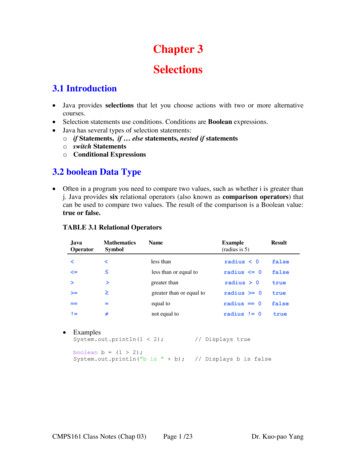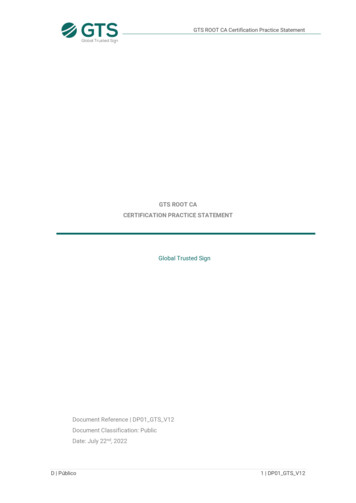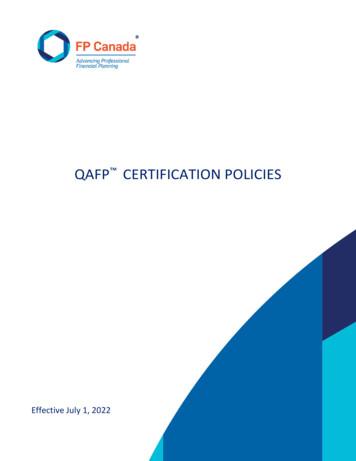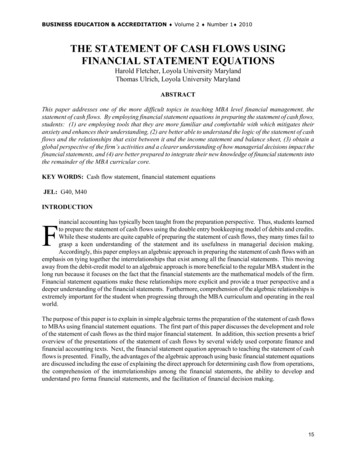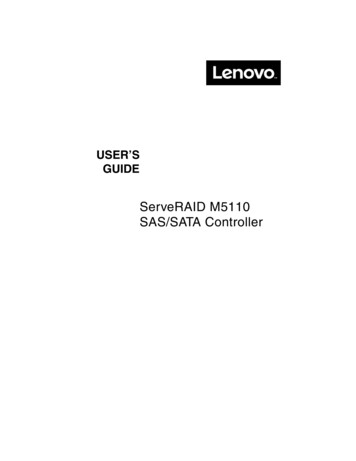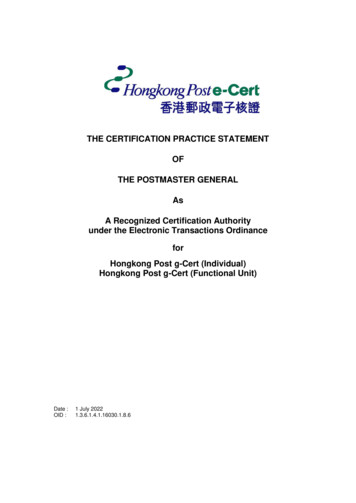
Transcription
THE CERTIFICATION PRACTICE STATEMENTOFTHE POSTMASTER GENERALAsA Recognized Certification Authorityunder the Electronic Transactions OrdinanceforHongkong Post g-Cert (Individual)Hongkong Post g-Cert (Functional Unit)Date :OID :1 July 20221.3.6.1.4.1.16030.1.8.6
Table of ContentsPREAMBLE. 41. INTRODUCTION. 61.1 Overview .61.2 Community and Applicability .61.2.1 Certification Authority . 61.2.2 Centrally Managed Messaging Platform . 71.2.3 End Entities . 71.2.4 Classes of Subscribers . 81.2.5 Certificate Lifespan . 91.2.6 Application via CMMP . 91.3 Contact Details . 101.4 Complaints Handling Procedures . 102. GENERAL PROVISIONS . 112.1 Obligations . 112.1.1 CA Obligations . 112.1.2 Contractor Obligations . 112.1.3 CMMP Obligations . 112.1.4 B/D/O Obligations . 122.1.5 Subscriber Obligations . 122.1.6 Relying Party Obligations . 132.2 Further Provisions . 132.2.1 Reasonable Skill and Care . 132.2.2 No Supply of Goods . 142.2.3 Limitation of Liability . 142.2.4 HKPost's Liability for Received but Defective Certificates . 172.2.5 Assignment by Subscriber . 172.2.6 Authority to Make Representations . 172.2.7 Variation . 172.2.8 Retention of Title . 172.2.9 Conflict of Provisions . 172.2.10 Fiduciary Relationships . 172.2.11 Cross Certification . 182.2.12 Financial Responsibility . 182.3 Interpretation and Enforcement (Governing Law) . 182.3.1 Governing Law . 182.3.2 Severability, Survival, Merger, and Notice . 182.3.3 Dispute Resolution Procedures . 182.3.4 Interpretation . 182.4 Subscription Fees . 182.5 Publication and Repository . 182.5.1 Certificate Repository Controls . 192.5.2 Certificate Repository Access Requirements . 192.5.3 Certificate Repository Update Cycle . 192.5.4 Permitted Use of Information Contained in the Repository . 192.6 Compliance Assessment . 192.7 Confidentiality . 193. IDENTIFICATION AND AUTHENTICATION . 203.1 Initial Application . 203.1.1 Types of Names . 203.1.2 Need for Names to be Meaningful. 213.1.3 Rules for Interpreting Various Names . 213.1.4 Name Uniqueness . 213.1.5 Name Claim Dispute Resolution Procedure . 213.1.6 Infringement and Violation of Trademarks . 213.1.7 Method to Prove Possession of the Private Key . 213.1.8 Authentication of Identity of g-Cert (Individual) Applicant . 213.2 Certificate Renewal . 223.2.1 g-Cert certificates . 221Certification Practice StatementHongkong Post g-Cert1 July 2022OID : 1.3.6.1.4.1.16030.1.8.6
3.2.2 Validity Period of Renewed g-Cert . 224. OPERATIONAL REQUIREMENTS . 234.1 Certificate Application . 234.2 Certificate Issuance . 234.3 Publication of g-Cert. 234.4 Certificate Revocation . 234.4.1 Circumstances for Revocation . 234.4.2 Revocation Request Procedure . 244.4.3 Service Pledge & Certificate Revocation List Update . 254.4.4 Effect of Revocation . 264.5 Computer Security Audit Procedures . 264.5.1 Types of Events Recorded . 264.5.2 Frequency of Processing Log . 264.5.3 Retention Period for Audit Logs. 264.5.4 Protection of Audit Logs . 264.5.5 Audit Log Backup Procedures . 264.5.6 Audit Information Collection System . 264.5.7 Notification of Event-Causing Subject to HKPost . 274.5.8 Vulnerability Assessments . 274.6 Records Archival . 274.6.1 Types of Records Archived . 274.6.2 Archive Retention Period . 274.6.3 Archive Protection . 274.6.4 Archive Backup Procedures . 274.6.5 Timestamping . 274.7 Key Changeover . 274.8 Disaster Recovery and Key Compromise Plans . 274.8.1 Disaster Recovery Plan . 274.8.2 Key Compromise Plan . 284.8.3 Key Replacement. 284.9 CA Termination . 284.10 RA of B/D/O Termination . 285. PHYSICAL, PROCEDURAL AND PERSONNEL SECURITY CONTROLS . 295.1 Physical Security . 295.1.1 Site Location and Construction . 295.1.2 Access Controls . 295.1.3 Power and Air Conditioning . 295.1.4 Natural Disasters . 295.1.5 Fire Prevention and Protection . 295.1.6 Media Storage. 295.1.7 Off-site Backup . 295.1.8 Protection of Paper Documents . 295.2 Procedural Controls . 295.2.1 Trusted Role . 295.2.2 Transfer of Document and Data between HKPost, Contractors, CMMP and RAs . 295.2.3 Annual Assessment . 305.3 Personnel Controls . 305.3.1 Background and Qualifications . 305.3.2 Background Investigation . 305.3.3 Training Requirements . 305.3.4 Documentation Supplied To Personnel . 306. TECHNICAL SECURITY CONTROLS . 316.1 Key Pair Generation and Installation . 316.1.1 Key Pair Generation . 316.1.2 Subscriber Public Key Delivery to Certificate Issuer . 316.1.3 Public Key Delivery to Relying Parties . 316.1.4 Key Sizes . 316.1.5 Standards for Cryptographic Module . 316.1.6 Key Usage Purposes . 31Certification Practice StatementHongkong Post g-Cert1 July 2022OID : 1.3.6.1.4.1.16030.1.8.62
6.2 Private Key Protection. 316.2.1 Standards for Cryptographic Module . 316.2.2 Private Key Multi-Person Control . 316.2.3 Private Key Escrow . 316.2.4 Backup of HKPost Private Keys. 326.3 Other Aspects of Key Pair Management . 326.4 Computer Security Controls . 326.5 Life Cycle Technical Security Controls . 326.6 Network Security Controls . 326.7 Cryptographic Module Engineering Controls . 327. CERTIFICATE AND CERTIFICATE REVOCATION LIST PROFILES . 337.1 Certificate Profile . 337.2 Certificate Revocation List Profile . 338. CPS ADMINISTRATION. 34Appendix A - Glossary. 35Appendix B - Hongkong Post g-Cert Format . 39Appendix C - Hongkong Post Certificate Revocation Lists (CRLs) and Authority Revocation List(ARL) Format. 43Appendix D - Summary of Hongkong Post g-Cert Features . 46Appendix E - List of Subscriber Organisation / Registration Authorities and CMMP for theHongkong Post g-Cert, if any . 47Appendix F - List of Subcontractor(s) of Certizen Limited for Hongkong Post g-Cert Services, ifany . 50Appendix G - Lifespan of CA root certificates . 51Appendix H - List of the Designated Applications of Hongkong Post g-Cert Certificates . 52Certification Practice StatementHongkong Post g-Cert1 July 2022OID : 1.3.6.1.4.1.16030.1.8.63
COPYRIGHT of this document is vested in the Postmaster General. This documentmay not be reproduced in whole or in part without the express permission of thePostmaster General.PREAMBLEThe Electronic Transactions Ordinance (Cap. 553) (the "Ordinance") sets out the legalframework for the public key infrastructure (PKI) initiative. The PKI facilitates the use ofelectronic transactions for commercial and other purposes. The PKI is composed of manyelements, including legal obligations, policies, hardware, software, databases, networks, andsecurity procedures.Public Key Cryptography involves the use of a Private Key and a Public Key. A Public Key andits corresponding Private Key are mathematically related. The main principle behind Public KeyCryptography used in electronic transactions is that a message that is encrypted with a PublicKey can only be decrypted with its corresponding Private Key, and a message that is encryptedwith a Private Key can only be decrypted by its corresponding Public Key.The PKI is designed to support the use of such a method for commercial and other transactionsin Hong Kong Special Administrative Region of the People’s Republic of China (“Hong KongSAR”).Under the Ordinance, the Postmaster General is a Recognized Certification Authority ("CA") forthe purposes of the Ordinance and the PKI. Under the Ordinance the Postmaster General mayperform the functions and provide the services of a CA by the officers of the Hong Kong PostOffice. The Postmaster General has decided so to perform his functions, and he is thereforereferred for the purposes of this document as HKPost.Since 1 April 2007, the HKPost CA operations have been outsourced with private sectorparticipation. Currently, HKPost has awarded a contract (“Contract”) to Certizen Limited foroperating and maintaining the systems and services of the HKPost CA as stipulated in this CPSfrom 1 January 2020 to 30 June 2022, and an extended period up to 30 June 2023 (dateinclusive).Under the Contract, Certizen Limited, after obtaining the prior written consent of HKPost, mayappoint Subcontractor(s) for the performance of part of the Contract. A list of Subcontractor(s)of Certizen Limited, if any, can be found in Appendix F. Certizen Limited, together with itsSubcontractor(s) under the Contract, if any, is hereafter referred to as the “Contractor” for thepurpose of this CPS.HKPost remains a recognized CA under Section 34 of the Ordinance and the Contractor is anagent of HKPost appointed pursuant to Section 3.2 of the Code of Practice for RecognizedCertification Authorities issued by the Government Chief Information Officer under Section 33of the Ordinance.HKPost, as a recognized CA, is responsible under the Ordinance for the use of a TrustworthySystem for the issuance, revocation and publication in a publicly available Repository ofrecognized and accepted digital certificates for secure on-line identification. The g-Cert(Individual) and g-Cert (Functional Unit) certificates issued under this CPS areRecognized Certificates under the Ordinance and are referred to as “Certificates” or “gCerts” in this CPS.Under the Ordinance HKPost may do anything that is expedient for the performance of thefunctions, and the provision of the services, of a CA and under the Code of Practice forRecognized Certification Authorities issued by the Government Chief Information Officer,HKPost may appoint agents or subcontractors to carry out some or all of its operations.Certification Practice StatementHongkong Post g-Cert1 July 2022OID : 1.3.6.1.4.1.16030.1.8.64
This CPS sets out practices and standards for g-Cert, and the structure of this CPS is as follows:Section 1 provides an overview and contact detailsSection 2 sets out the responsibilities and liabilities of the partiesSection 3 sets out application and identity confirmation proceduresSection 4 describes the operational requirementsSection 5 presents the security controlsSection 6 sets out how the Public/Private Key pairs will be generated and controlledSection 7 describes the certificate and certificate revocation list profilesSection 8 documents how this CPS will be administeredAppendix A contains a glossaryAppendix B contains a Hongkong Post g-Certs formatAppendix C contains a Hongkong Post Certificate Revocation List (CRL) and AuthorityRevocation List (ARL) formatAppendix D contains a summary of Hongkong Post g-Certs featuresAppendix E contains a list of Subscriber Organisation / Registration Authorities (RAs) andCMMP for Hongkong Post g-Cert, if anyAppendix F contains a list of Subcontractor(s) of Certizen Limited for Hongkong Post gCerts Services, if anyAppendix G describes lifespan of CA root certificatesAppendix H contains a list of Designated Applications of Hongkong Post g-CertsCertificatesCertification Practice StatementHongkong Post g-Cert1 July 2022OID : 1.3.6.1.4.1.16030.1.8.65
1. INTRODUCTION1.1 OverviewThis Certification Practice Statement ("CPS") is published for public knowledge by HKPost andspecifies the practices and standards that HKPost employs in issuing, revoking and publishingcertificates.The Internet Assigned Numbers Authority (“IANA”) has assigned the Private Enterprise Number16030 to HKPost. For identification purpose, this CPS bears an Object Identifier (“OID”)“1.3.6.1.4.1.16030.1.8.6” (see description of the field “Certificate Policies” in Appendix B).This CPS sets out the roles, functions, obligations, and potential liabilities of the participants inthe system used by HKPost. It specifies the procedures used to confirm the identity of allApplicants for certificates issued under this CPS and describes the operational, procedural, andsecurity requirements of HKPost.Certificates issued by HKPost in accordance with this CPS will be relied upon by Relying Partiesand used to verify Digital Signatures. Each Relying Party making use of a HKPost issuedcertificate must make an independent determination that PKI based Digital Signatures areappropriate and sufficiently trusted to be used to authenticate the identity of the participants inthe Designated Application of the certificate. Relying Party must not make use of the HKPostissued certificate in any PKI applications other than the Designated Application in respect ofthe Subscriber Organisation of the certificate listed in Appendix H.Offer of g-Cert certificates requires prior arrangement between the subscriber organisation andHKPost before HKPost issues g-Cert certificates for that subscriber organisation.Under the Ordinance, HKPost is a recognized CA. HKPost has designated the g-Cert(Individual), g-Cert (Functional Unit) certificates issued under this CPS as RecognizedCertificates. This means for both Subscribers and Relying Parties, that HKPost has a legalobligation under the Ordinance to use a Trustworthy System for the issuance, revocation andpublication in a publicly available Repository of accepted Recognized Certificates. RecognizedCertificates have characteristics of accuracy and contain representations of fact which aredefined in law by the Ordinance, including a representation (as further defined below) that suchcertificates have been issued in accordance with this CPS. The fact that HKPost has appointedagents or contractors or subcontractors does not diminish HKPost's obligation to use aTrustworthy System, nor does it alter the characteristics that g-Cert certificates have asrecognized certificates.A summary of the g-Cert features is in Appendix D.1.2 Community and Applicability1.2.1 Certification AuthorityUnder this CPS, HKPost performs the functions and assumes the obligations of a CA. HKPostis the only CA authorised to issue certificates under this CPS (see Section 2.1.1).1.2.1.1 Representations by HKPostBy issuing a certificate that refers to this CPS, HKPost represents to Relying Parties who act inaccordance with Section 2.1.6 and other relevant sections of this CPS, that HKPost has issuedthe certificate in accordance with this CPS. By publishing a certificate that refers to this CPS,HKPost represents to Relying Parties who act in accordance with Section 2.1.6 and otherrelevant sections of this CPS that HKPost has issued the certificate to the Subscriber identifiedin it.1.2.1.2 EffectHKPost publishes recognized certificates that are accepted by and issued to its Subscribers ina Repository. (See Section 2.5)Certification Practice StatementHongkong Post g-Cert1 July 2022OID : 1.3.6.1.4.1.16030.1.8.66
1.2.1.3 HKPost's Right to SubcontractHKPost may further subcontract its obligations for performing some or all of the functionsrequired by this CPS and the Subscriber Agreement provided that the subcontractor agrees toundertake to perform those functions and enters into a contract with HKPost to perform theservices. In the event that such sub-contracting occurs, HKPost shall remain liable for theperformance of the CPS and the Subscriber Agreement as if such sub-contracting had notoccurred.1.2.2 Centrally Managed Messaging PlatformCentrally Managed Messaging Platform under the administration and support of OGCIO(hereafter referred to as CMMP) is to provide various Designated Applications in Appendix Hfor use by Bureau/Department/Office of the Government of Hong Kong SAR (“B/D/O”). TheCMMP will adopt X.509 v3 digital certificates, the new special purpose digital certificates issuedby Hongkong Post Certification Authority (HKPCA), to handle restricted informationHKPost deals with the Applicant or Subscriber of g-Cert via the role of Requester assigned inCMMP. In this regard, CMMP is the agent serving the Applicant for and Subscriber of g-Cert.At the same time, the role of Business Administrator is assigned by B/D/O in CMMP to verifythe identity of the Applicant for g-Cert. In this regard, Business Administrator acts asRegistration Authority for g-Cert (hereafter referred to as Registration Authority (“RA”)).All other functions and obligations, including the functions to be performed by CMMP arisingfrom the certificate life-cycle management and the usage from time to time of the g-Cert,regardless of the nature of the Designated Application, are functions and obligationsundertaken by CMMP whether as principal or as agent for its Subscriber but not as subcontractor or agent for the Contractor and for HKPost.1.2.3 End EntitiesUnder this CPS there are two types of end entities, Subscribers and Relying Parties. ASubscriber is the “Subscriber” or “Subscriber Organisation” referred to in Appendix A. RelyingParties are entities that have relied on any class or category of g-Cert for use in a transactionof the Designated Application referred to in Appendix H. For the avoidance of doubt, RelyingParties should not rely on the B/D/O or the Contractor. For g-Cert certificates that are issuedvia the B/D/O or the Contractor, the B/D/O and the Contractor do not owe a duty of care andare not responsible to the Relying Parties in anyway for the issue of those g-Cert certificates(see also Section 2.1.4). Subscribers who rely on an g-Cert of another Subscriber for use ina transaction of the Designated Application of the Subscriber Organisation referred to inAppendix H will be Relying Parties in respect of such a certificate.1.2.3.1 Warranties and Representations by Applicants and SubscribersEach Applicant (represented by a Requester in the case of applying for an g-Cert certificate)must sign, or confirm his/her acceptance of, an agreement (in the terms specified in this CPS)which includes a term by which the Applicant agrees that by accepting a certificate issued underthis CPS, the Applicant/Subscriber Organisation warrants (promises) to HKPost and representsto all other relevant parties (and in particular Relying Parties) that during the operational periodof the certificate the following facts are and will remain true:a) Designated Applications effectuated using the private key corresponding to the publickey included in the certificate are the acts of the Subscriber and that the certificate hasbeen accepted and is properly operational at the time throughout the validity of thecertifica
The PKI is designed to support the use of such a method for commercial and other transactions in Hong Kong Special Administrative Region of the People's Republic of China ("Hong Kong SAR"). Under the Ordinance, the Postmaster General is a Recognized Certification Authority ("CA") for the purposes of the Ordinance and the PKI.



